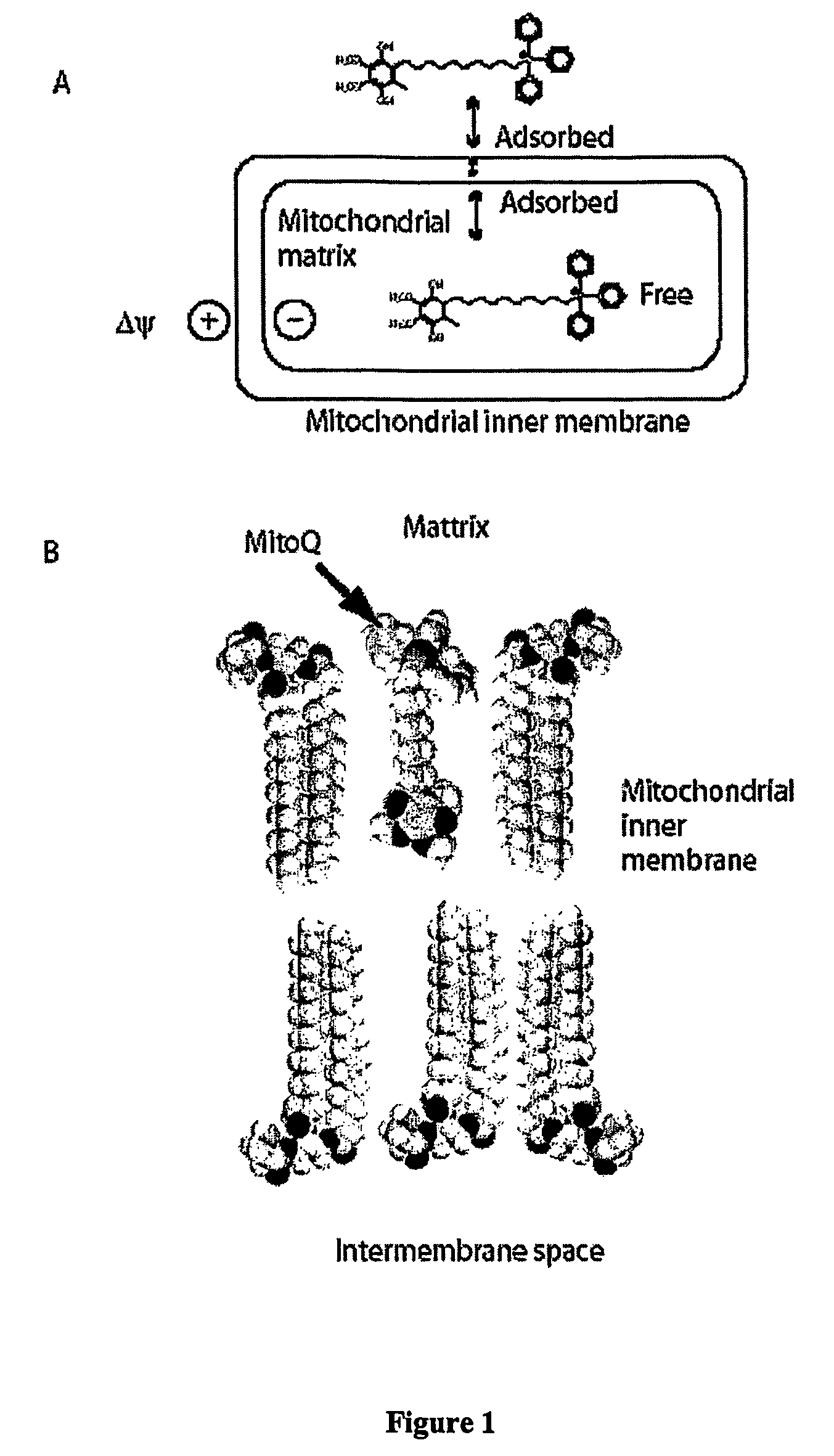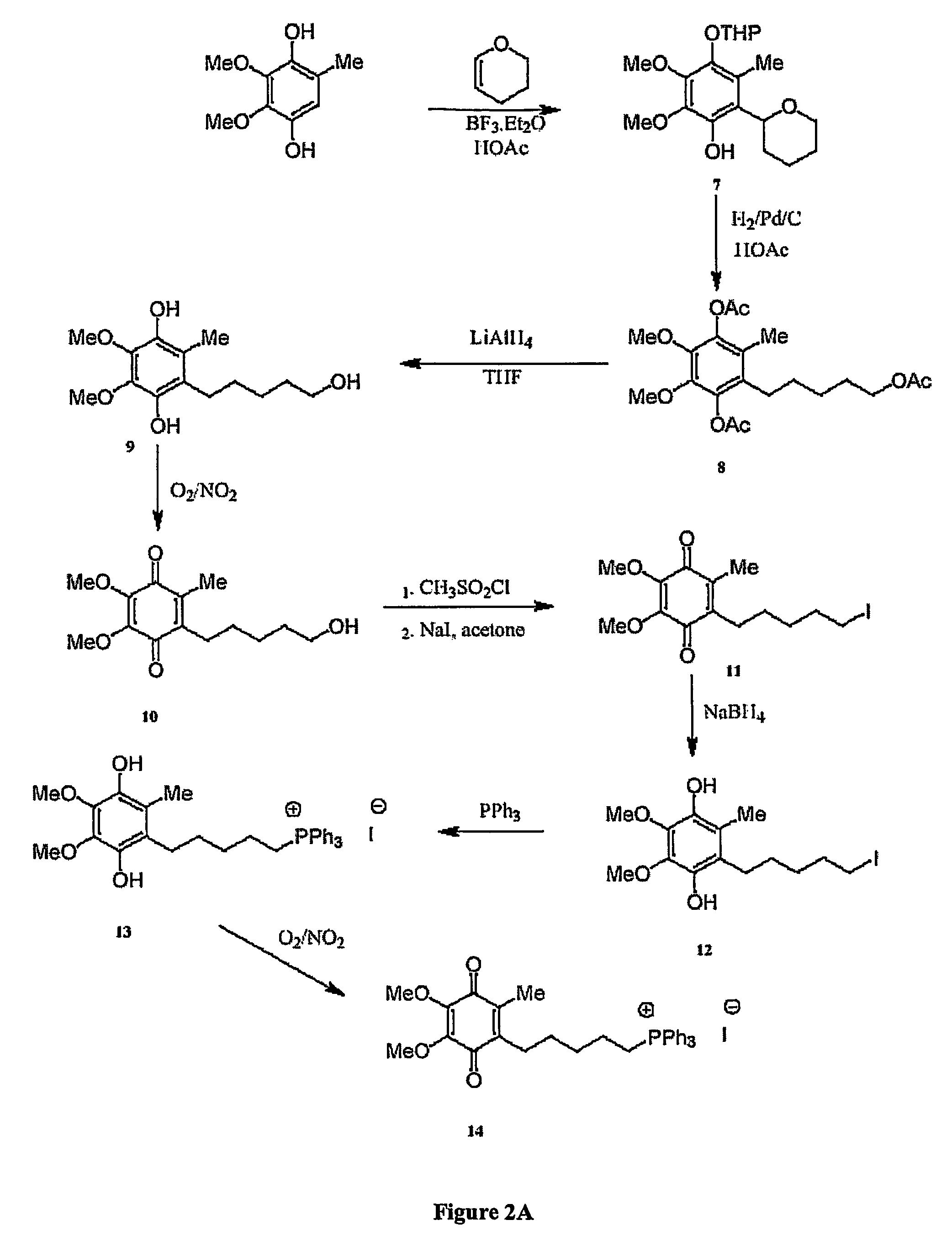Mitoquinone derivatives used as mitochondrially targeted antioxidants
a technology of mitochondrial targeting and mitoquinone derivatives, applied in the field of amphiphilic antioxidants, can solve the problems of unfavorable physicochemical properties, less than optimal effectiveness of antioxidants, and inability to meet the needs of use, and achieve the effect of reducing the symptoms of aging
- Summary
- Abstract
- Description
- Claims
- Application Information
AI Technical Summary
Benefits of technology
Problems solved by technology
Method used
Image
Examples
example 1
Synthesis of Exemplary Mitochondrially Targeted Antioxidant Compound, Compound 2
3,4-Dimethoxy-5-methyl-1,4-benzenediol (6) (CAS Reg 3066-90-8)
[0246]
[0247]A solution of 2,3-dimethoxy-5-methyl-2,5-cyclohexadiene-1,4-dione (CoQ0) (CAS Reg 605-94-7) (5) (14.62 g, 80.25 mmol) in a mixture of ether (220 mL) and methanol (109 mL) at room temperature was added dropwise to a stirred solution of NaBH4 (15 g, 396 mmol) in H2O (440 mL). The red color of the oxidize (5) was changed to yellow on each addition. After stirring 15 mins at room temperature, the ether phase was separated and the aqueous phase extracted twice with ether (200 mL). The combined ethereal extracts were washed with saturated aqueous NaCl (300 mL), dried (MgSO4), filtered and evaporated in vacuo (20 mm Hg) to give pure 6 as a yellow liquid (13.65 g, 93%).
[0248]1H NMR (299.9 MHz) δ 6.48 (1H, s, Ar—H), 3.91, 3.88 (6H, s, Ome), 2.17 (3H, s, Me).
1,2,3,4-Tetramethoxy-5-methyl-benzene (7) (CAS Reg 35896-58-3)
[0249]
[0250]A solution...
example 2
Synthesis of Exemplary Mitochondrially Targeted Antioxidant Compounds, Mitoquinone-C5 and Mitoquinone-C15
[0279]The chemical syntheses of Mitoquinone-C5 and Mitoquinone-C15 are outlined in FIG. 2 and are described below. Nuclear magnetic resonance spectra were acquired using a Varian 300 MHz instrument. For 1H-NMR tetramethylsilane was the internal standard in CDCl3. For 31P NMR 85% phosphoric acid was the external standard. Chemical shifts (8) are in ppm relative to the standard. Elemental analyses were done by the Campbell Microanalytical Laboratory, University of Otago. Electrospray mass spectrometry was done using a Shimadzu LCMS-QP800X liquid chromatography mass spectrometer. Stock solutions were prepared in absolute ethanol and stored at −20° C. in the dark.
[0280]Mitoquinone-C5 (14). The synthetic route to Mitoquinone-C5 is shown in FIG. 2A. Dihydropyran (46.83 g, 0.55 mol) was added to 2,3-dimethoxy-5-methyl-1,4-benzohydroquinone (CoQ0) (50 g, 0.275 mol) dissolved in acetic ac...
example 3
Properties of Mitochondrially Targeted Antioxidant Compounds
[0288]The present invention recognises that, in order to be suitable in a wide variety of applications, for example the formulation of dosage forms such as tablets, there is advantage in being able to form a crystalline or solid form of the mitochondrially targeted antioxidant compound. Similarly, it is believed, without wishing to be bound by any theory, that mitochondrially targeted antioxidant compounds with low partition coefficients (octanol:water) may exhibit enhanced bioavailability with respect to those compounds having higher partition coefficients, such that a low partition coefficient is desirable for certain applications, and that the antioxidant functionality of the compounds of the present invention are at least in part determined by their physicochemical properties.
[0289]The partition coefficients for a variety of antioxidant compounds are shown in Table 1. Octan-1-ol / PBS partition coefficients were determine...
PUM
| Property | Measurement | Unit |
|---|---|---|
| distance | aaaaa | aaaaa |
| distance | aaaaa | aaaaa |
| distance | aaaaa | aaaaa |
Abstract
Description
Claims
Application Information
 Login to View More
Login to View More - R&D
- Intellectual Property
- Life Sciences
- Materials
- Tech Scout
- Unparalleled Data Quality
- Higher Quality Content
- 60% Fewer Hallucinations
Browse by: Latest US Patents, China's latest patents, Technical Efficacy Thesaurus, Application Domain, Technology Topic, Popular Technical Reports.
© 2025 PatSnap. All rights reserved.Legal|Privacy policy|Modern Slavery Act Transparency Statement|Sitemap|About US| Contact US: help@patsnap.com



